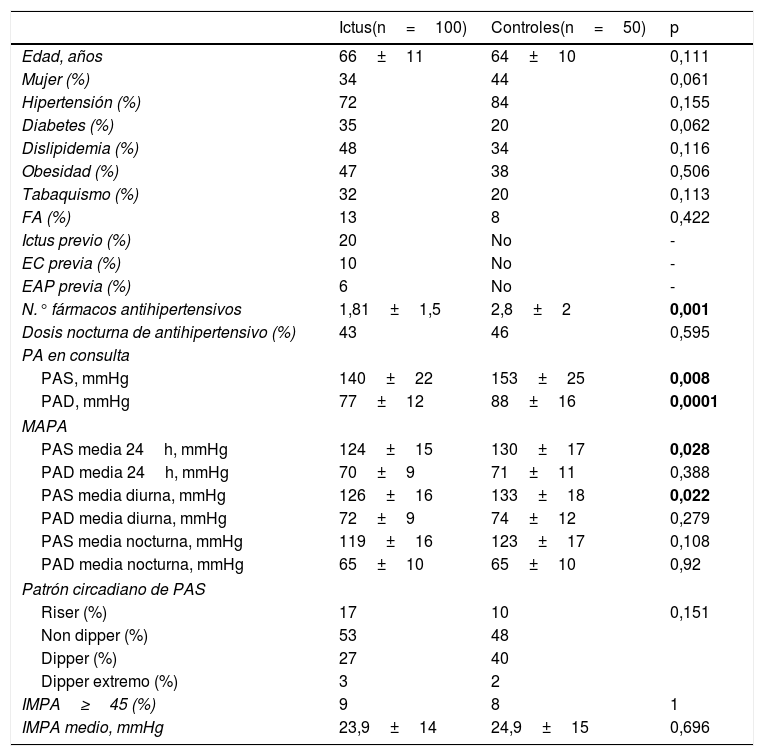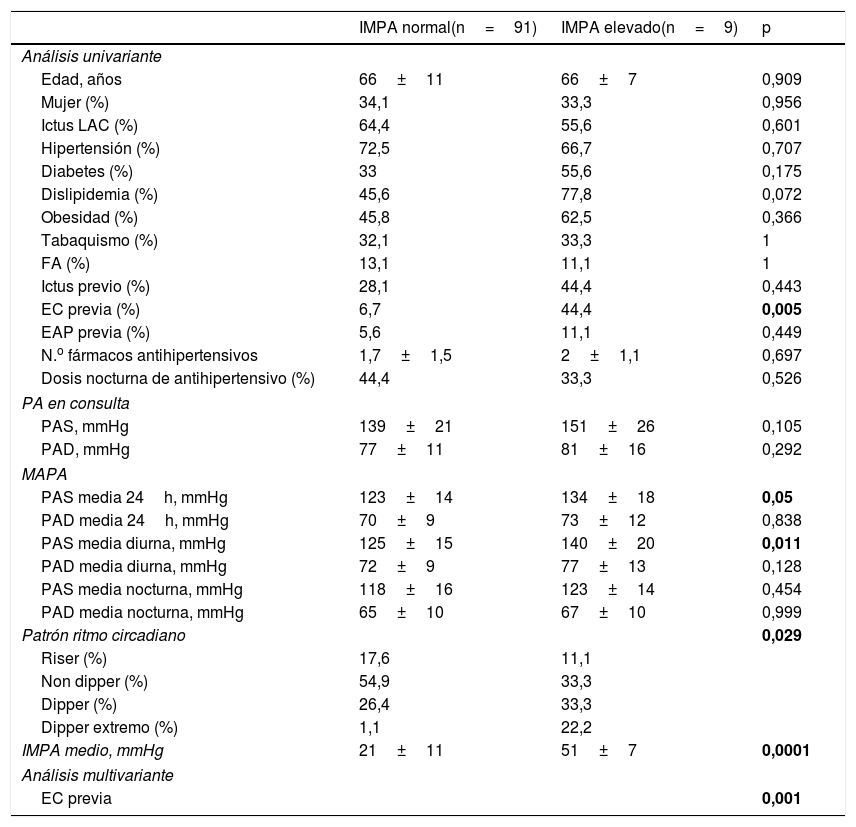Un incremento matutino de presión arterial (IMPA) elevado se asocia con la aparición de eventos cardiovasculares. Evaluamos la presencia de un IMPA elevado en pacientes con ictus isquémico reciente.
Material y métodosSe realizó un estudio casos-control. Se incluyeron 100 pacientes con un ictus isquémico en los 6 meses previos y 50 pacientes hipertensos sin enfermedad cardiovascular como controles.
ResultadosSe estudiaron 61 ictus lacunares (LAC) y 39 no lacunares (NLAC). La edad media fue de 65±11 años, y 60 (40%) pacientes eran mujeres.
El IMPA elevado estaba presente en el 9% de los ictus (en 5 LAC y 4 NLAC) y en el 8% de los controles (p no significativa [NS]), con un valor medio similar de IMPA en ambos grupos: 23,9±14mmHg y 24,9±15mmHg respectivamente (p=NS), aunque los pacientes controles presentaron una PA más alta en consulta (sistólica [p=0,008] y diastólica [p=0,0001]), PA sistólica de 24h (p=0,028) y PA sistólica diurna (p=0,022). Entre los pacientes con ictus, un IMPA elevado se asoció con enfermedad coronaria previa (p=0,005), con el patrón circadiano de PA (p=0,029), pero no con el tratamiento antihipertensivo prescrito. En el análisis multivariante, el IMPA elevado solo se asoció con enfermedad coronaria previa (p=0,001).
ConclusionesAproximadamente uno de cada 10 pacientes con ictus isquémico reciente presenta un IMPA elevado. Se deberían implementar estrategias para la detección y tratamiento del IMPA tras un ictus.
High morning BP surge (MBPS) has been associated with an increased risk of cardiovascular events. We evaluated the presence of a high MBPS in patients with recent ischaemic stroke.
Material and methodsA case-control study was carried out. One hundred patients with an ischaemic stroke in the previous 6 months and fifty hypertensive patients without cardiovascular disease were included as controls.
Results61 lacunar (LAC) and 39 non-lacunar (NLAC) strokes were studied. The mean age was 65±11 years, and 60 (40%) patients were women. High MBPS was present in 9% of strokes (in 5 LAC and 4 NLAC) and in 8% of controls (p not significant [NS]), with a similar mean value of MBPS in both groups: 23.9±14mmHg and 24.9±15mmHg respectively (p=NS), although the control patients had a higher office BP (systolic [p=.008] and diastolic [p=.0001]), 24h systolic BP (p=.028) and daytime systolic BP (p=.022). Among the stroke patients, high MBPS was associated with previous coronary heart disease (p=.005), circadian BP pattern (p=.029), but not with the type of antihypertensive treatment prescribed. In multivariate analysis, elevated MBPS was only associated with previous coronary artery disease (p=.001).
ConclusionsApproximately one in ten patients with recent ischaemic stroke has a high MBPS. Strategies to detect and treat high MBPS after a stroke are needed.
Artículo
Comprando el artículo el PDF del mismo podrá ser descargado
Precio 19,34 €
Comprar ahora








